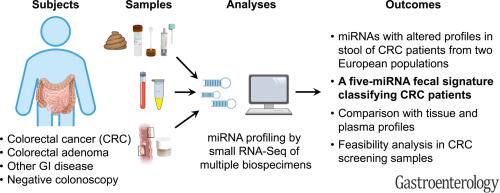Gastroenterology ( IF 25.7 ) Pub Date : 2023-05-30 , DOI: 10.1053/j.gastro.2023.05.037 Barbara Pardini 1 , Giulio Ferrero 2 , Sonia Tarallo 1 , Gaetano Gallo 3 , Antonio Francavilla 4 , Nicola Licheri 5 , Mario Trompetto 6 , Giuseppe Clerico 6 , Carlo Senore 7 , Sergio Peyre 8 , Veronika Vymetalkova 9 , Ludmila Vodickova 9 , Vaclav Liska 10 , Ondrej Vycital 10 , Miroslav Levy 11 , Peter Macinga 12 , Tomas Hucl 12 , Eva Budinska 13 , Pavel Vodicka 9 , Francesca Cordero 5 , Alessio Naccarati 1

|
Background & Aims
Fecal tests currently used for colorectal cancer (CRC) screening show limited accuracy in detecting early tumors or precancerous lesions. In this respect, we comprehensively evaluated stool microRNA (miRNA) profiles as biomarkers for noninvasive CRC diagnosis.
Methods
A total of 1273 small RNA sequencing experiments were performed in multiple biospecimens. In a cross-sectional study, miRNA profiles were investigated in fecal samples from an Italian and a Czech cohort (155 CRCs, 87 adenomas, 96 other intestinal diseases, 141 colonoscopy-negative controls). A predictive miRNA signature for cancer detection was defined by a machine learning strategy and tested in additional fecal samples from 141 CRC patients and 80 healthy volunteers. miRNA profiles were compared with those of 132 tumors/adenomas paired with adjacent mucosa, 210 plasma extracellular vesicle samples, and 185 fecal immunochemical test leftover samples.
Results
Twenty-five miRNAs showed altered levels in the stool of CRC patients in both cohorts (adjusted P < .05). A 5-miRNA signature, including miR-149-3p, miR-607-5p, miR-1246, miR-4488, and miR-6777-5p, distinguished patients from control individuals (area under the curve [AUC], 0.86; 95% confidence interval [CI], 0.79–0.94) and was validated in an independent cohort (AUC, 0.96; 95% CI, 0.92–1.00). The signature classified control individuals from patients with low-/high-stage tumors and advanced adenomas (AUC, 0.82; 95% CI, 0.71–0.97). Tissue miRNA profiles mirrored those of stool samples, and fecal profiles of different gastrointestinal diseases highlighted miRNAs specifically dysregulated in CRC. miRNA profiles in fecal immunochemical test leftover samples showed good correlation with those of stool collected in preservative buffer, and their alterations could be detected in adenoma or CRC patients.
Conclusions
Our comprehensive fecal miRNome analysis identified a signature accurately discriminating cancer aimed at improving noninvasive diagnosis and screening strategies.
中文翻译:

通过小 RNA 测序获得的粪便 MicroRNA 特征可准确区分结直肠癌:多中心研究结果
背景与目标
目前用于结直肠癌(CRC)筛查的粪便检测在检测早期肿瘤或癌前病变方面的准确性有限。在这方面,我们全面评估了粪便 microRNA (miRNA) 谱作为无创 CRC 诊断的生物标志物。
方法
在多个生物样本中总共进行了 1273 个小 RNA 测序实验。在一项横断面研究中,对来自意大利和捷克队列的粪便样本(155 例 CRC、87 例腺瘤、96 例其他肠道疾病、141 例结肠镜检查阴性对照)的粪便样本中的 miRNA 进行了研究。通过机器学习策略定义了用于癌症检测的预测性 miRNA 特征,并在 141 名 CRC 患者和 80 名健康志愿者的其他粪便样本中进行了测试。将 miRNA 谱与 132 个与邻近粘膜配对的肿瘤/腺瘤、210 个血浆细胞外囊泡样本和 185 个粪便免疫化学测试剩余样本的 miRNA 谱进行比较。
结果
两个队列中 CRC 患者粪便中 25 种 miRNA 的水平发生了变化(调整后的P < .05)。 5-miRNA 特征,包括 miR-149-3p、miR-607-5p、miR-1246、miR-4488 和 miR-6777-5p,将患者与对照个体区分开来(曲线下面积 [AUC],0.86; 95% 置信区间 [CI],0.79–0.94)并在独立队列中得到验证(AUC,0.96;95% CI,0.92–1.00)。该特征对来自低/高阶段肿瘤和晚期腺瘤患者的对照个体进行分类(AUC,0.82;95% CI,0.71-0.97)。组织 miRNA 谱与粪便样本的 miRNA 谱相似,不同胃肠道疾病的粪便谱突显了 CRC 中 miRNA 的特异失调。粪便免疫化学测试剩余样本中的 miRNA 谱与保存在保存缓冲液中的粪便中的 miRNA 谱显示出良好的相关性,并且可以在腺瘤或 CRC 患者中检测到它们的变化。
结论
我们全面的粪便 miRNome 分析确定了一个能够准确区分癌症的特征,旨在改进非侵入性诊断和筛查策略。











































 京公网安备 11010802027423号
京公网安备 11010802027423号